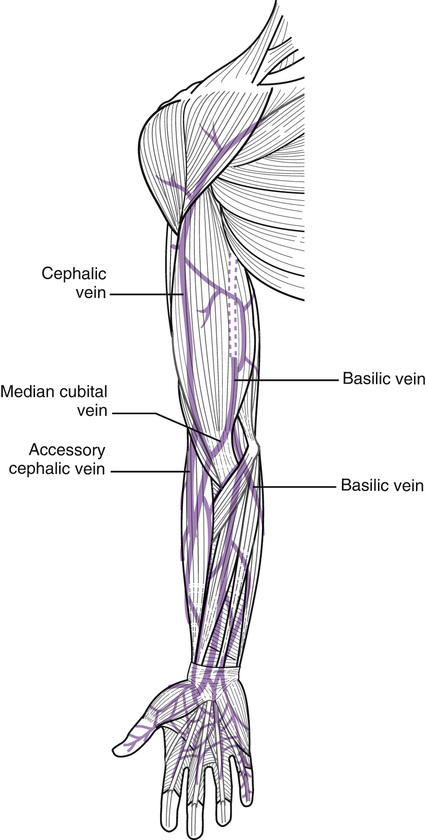Principles of phlebotomy and intravenous therapy
Maternal venepuncture
Learning outcomes
Having read this chapter, the reader should be able to:
• discuss the indications for venepuncture
• describe how venepuncture is undertaken safely and positively using an Aseptic Non Touch Technique (ANTT) (Rowley & Clare 2011)
• discuss the rationale for the choice of vein and equipment used
• highlight the possible complications and how they can be avoided
Venepuncture is the puncturing of a vein with a needle, usually to obtain specimens of blood for laboratory analysis, but may also include the administration of drugs intravenously in an emergency. The ability of a midwife to undertake venepuncture facilitates individualized and holistic care for the woman from the same practitioner. This chapter considers the indications for venepuncture, the rationale for correct preparation, and the procedure. The role and responsibilities of the midwife are summarized. This chapter should be read alongside Chapters 8 and 10 for a fuller understanding.
Indications
• Antenatal screening tests for fetal normality, e.g. alphafetoprotein
• Cross-matching prior to blood transfusion, or ‘group and save’ prior to operative delivery.
This is not an exhaustive list, but it does indicate that women are often asked to give blood specimens. Fear of needles or of fainting can be real fears; midwives should be sensitive to both the physical and psychological aspects of the skill. Care and time should be taken to gain an informed consent and measures used to improve the experience (see below) if the woman is very anxious. An ANTT technique should be used (Chapter 10); bloodstream infections are serious (RCN 2010), debilitating and expensive.
Suitable sites
Blood is always taken from a vein, never an artery. Arterial blood is only ever sought by medical staff in specific circumstances (e.g. for blood gas analysis). The physiological additional blood volume during pregnancy and the general body warmth of the pregnant woman both create vasodilatation, making venepuncture easier than with many other groups of people. As healthy women, their veins are also often in a good condition. The midwife should appreciate the anatomy of the arm below the elbow. The basilic, median cubital and cephalic veins are all appropriately placed in the antecubital fossa and are suitable sites for effective venepuncture (Fig. 46.1). The skin should be free from infection, inflammation and bruising.
Choosing a vein
Clearly visible veins are often nearer to the skin surface but are often smaller and so are harder to obtain blood samples from. Both visual inspection and palpation should be used when choosing a vein. On palpation a vein can be assessed for its size, mobility and suitability. A vein that has been repeatedly used for venous access may be thrombosed and will not feel ‘bouncy’ and full. The veins in the antecubital fossa are often supported by subcutaneous tissue and so are less likely to move or ‘roll’ when venepuncture is attempted. The application of a tourniquet that obstructs the venous return only (arterial pulse should still be felt) increases venous filling and so makes the choice of vein easier. Scales (2008) indicates that tourniquet use should be for a maximum of 1 minute. Lavery & Ingram (2005) agree, suggesting that tourniquet use for greater than 90 seconds damages the vein and therefore causes potentially inaccurate results. This means that it will be released while the other preparations are made and then reapplied once ready to puncture. The woman can also be asked to clench and unclench her fist a couple of times, but this is not always necessary and can also affect the results. The technique of ‘tapping’ the veins to increase their prominence should be avoided; it can cause bruising and pain (Brooks 2014). Often women will know from past experience which are their ‘good’ veins. Palpating the vein also allows the midwife to avoid three other structures:
Stay updated, free articles. Join our Telegram channel

Full access? Get Clinical Tree



